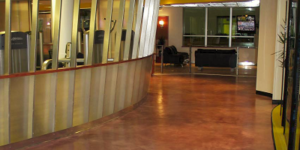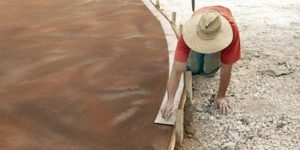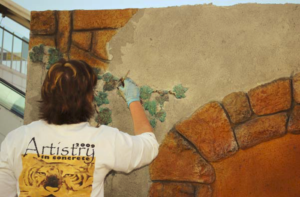One of the many things I love about our industry is meeting folks that share my passion for decorative concrete. Most of us picture the decorative stars coming from places like California, Texas, Arizona and Florida, but this is not always the case. I have felt for a long time that our industry has talent in small markets that the exposure train doesn’t pass close to – artists that design or install top-notch jobs day in and day out and never consider themselves to be anything special. You see, without competition, it can be difficult to know how good you really are. I recently heard of such a couple in northeastern Wyoming and took a look to see what the fuss was all about. I was blown away, to say the least.
Wayne and Pamela Gable of Sheridan, Wyo., operate a company called, simply, Elements. Elements specializes in decorative concrete, both indoors and outdoors. As I spent time with these folks looking over portfolio pictures and travel samples of concrete counters, I couldn’t help but wonder what the heck these folks were doing way out here. I’m all about where the buffalo roam, but most companies that specialize in high-end work have traditionally been found a little closer to the city. Well, rethink the status quo, because the next few paragraphs will describe how small-town America can do decorative concrete like the big markets.
The logical question to ask is how did Pam and Wayne get involved in decorative concrete in the first place? It seems Pam was thumbing through a Fu-Tung Cheng book on concrete counters, and the pair thought it would be fun to try something like that in their own kitchen. They found themselves taking the first of four trips out to Cheng’s workshop in Berkeley, Calif., to learn the technical and artistic side of concrete counters. Next came GFRC, acid staining and Modellos, and they were off and running, combining decorative concrete with an existing landscape business. Pam says that concrete and landscaping go well together and one side can easily “spin off” to the other. Outdoor kitchens can lead to indoor concrete counters and acid-stain flooring.
I asked Wayne about establishing themselves and decorative concrete in a small market. It seems they tried newspaper advertising, home shows, etc., but word of mouth worked best. Many local folks didn’t understand what decorative concrete was until the Gables presented examples of how beautiful concrete could be. The process went from showing examples and answering questions to bidding work. Pam said local builders and architects have been the hardest market to penetrate, while homeowners (the end users) started requesting their services. Eventually the Gables trained under notable artisans such as Bob Harris and Melanie Royals, and they learned techniques by Buddy Rhodes as they expanded their decorative expertise.
My next two questions for the Gables concerned travel and obtaining materials. It seems Mullinax Construction Supply, a Sheridan supply house run by Aaron Mullinax, shared the same interest in decorative concrete and started to stock many of the products needed. The Mullinax family supplies their area with ready-mix concrete, so branching out into the decorative supply side made sense. Maintaining inventories of all colors and materials can be a challenge for them. Also, freight can be expensive in rural markets. And Sheridan, Wyo., can get cold, so some water-based projects have to be protected during shipping.
In answer to my other question about travel, the Gables have worked up to 425 miles from their home base in Sheridan. They say the secret to long-distance projects is a lot of planning before traveling. I was starting to feel a little sorry for these folks having to travel so far until I heard that the final destinations were sometimes places like Jackson Hole, Wyo. Pam says they have found a way to travel and let the projects pay for it – nice.
The Gables are currently working on fresh ideas such as curved walls and adjusting acid stains to have the look of watercolors. I asked if they had advice for our readers in markets like theirs. Pam and Wayne recommend starting small but being creative. Educate, but adapt to your local market. Be hands-on and challenge yourself to be the best possible. Sounds like a recipe for success regardless of your market to me.
What we can learn from businesses like Wayne and Pam’s is that the decorative industry is no longer limited to large cities or populated states. Customers, regardless of demographics, can see artistic quality and will appreciate the value in what we do. If you are in a small market, don’t overlook the opportunities that lie firmly at the feet of our decorative industry. Test the waters with a few small jobs and take many pictures along the way. Think of it like you’re a big fish in a small pond and let me know how it goes.
Thanks, Wayne and Pam.
















